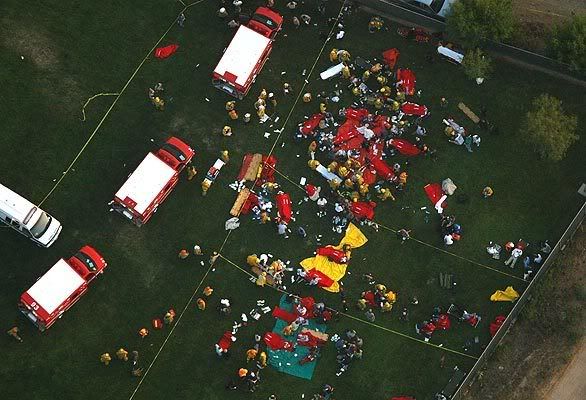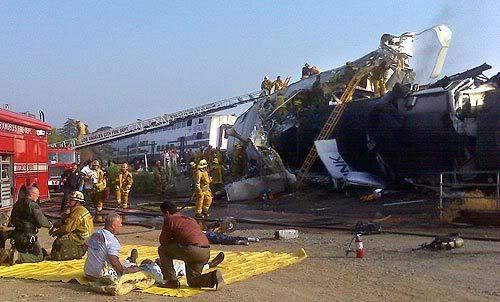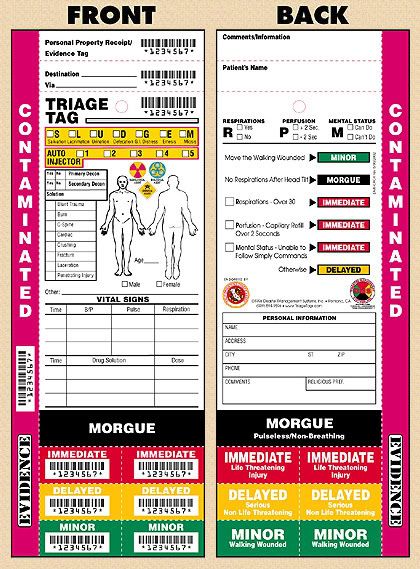START MCI Triage System and Triage Tags
Executive Summary: The LAFD (Los Angeles City Fire Department) recently dealt with one of the worst rail disasters in the history of California. To effectively deal with an incident of this magnitude, both the ICS System was employed as well as START Triage and Tagging.
This discussion reviews the basics of START Triage as well as the new Hazmat WMD Triage Tags. What is covered here is only the basics. What lessons have you learned to make a MCI event go more smoothly? Have you ever had to set up an air ops branch to handle medivac of critically injured patients? Do they use the same system in other parts of the world?
Are you prepared for this type of incident?

A freight train slammed headon into a metrolink commuter train filled with passengers.

Triage has been set up, using multi-colored tarps to help organize and sort out the victims.

Immediate staging areas where victims were first removed to were established prior to the set up of the larger triage area.
START Triage: Without wasting a lot of time explaining what triage is all about, one thing remains... You must have a thorough understanding of the START System for MCI Triage. For me, it's always been an easy thing to remember because we have a Fire Station No. 32. The pneumonic is 32 CAN DO which ties in the other half of the START pneumonics called RPM. You also need to have a good triage tag that is waterproof and has the needed information to document patient information.
Here's how they tie in together.
R - Respiration
P - Perfussion
M - Motor Skills
This system ties in RPM with specific numbers to remember, which are the number 30 and the number 2.
Respirations: If the respirations are more than 30 times a minute, you have a red tag priority patient.
Perfusion If the capillary refill once you pinch the nailbed in the hand takes longer than 2 seconds to refill, then you have a good chance that the person is going into shock. This is a red tag priority patient.
Mental Status If you ask the person to do something and they cannot respond appropriately, they may have a head injury and are considered a red tag priority patient.
Here's the algorhythm for START Triage:

Triage Tags: What makes this system work is the use of triage tags. The new tags contain many new features to address WMD events. Here's an example of the waterproof WMD Hazmat triage tags:

Key Point: Make sure that if you are going to deal with a hazmat decon situation then the triage tags must be waterproof. We did a local drill years ago, nurses and paramedics spent a lot of time writing on the tags what they noted during patient assessment. The bad news was that the decon showers wiped out all the information on the paper tags... Lessons learned... sure glad it was a drill...
This discussion reviews the basics of START Triage as well as the new Hazmat WMD Triage Tags. What is covered here is only the basics. What lessons have you learned to make a MCI event go more smoothly? Have you ever had to set up an air ops branch to handle medivac of critically injured patients? Do they use the same system in other parts of the world?
Are you prepared for this type of incident?

A freight train slammed headon into a metrolink commuter train filled with passengers.

Triage has been set up, using multi-colored tarps to help organize and sort out the victims.

Immediate staging areas where victims were first removed to were established prior to the set up of the larger triage area.
START Triage: Without wasting a lot of time explaining what triage is all about, one thing remains... You must have a thorough understanding of the START System for MCI Triage. For me, it's always been an easy thing to remember because we have a Fire Station No. 32. The pneumonic is 32 CAN DO which ties in the other half of the START pneumonics called RPM. You also need to have a good triage tag that is waterproof and has the needed information to document patient information.
Here's how they tie in together.
R - Respiration
P - Perfussion
M - Motor Skills
This system ties in RPM with specific numbers to remember, which are the number 30 and the number 2.
Respirations: If the respirations are more than 30 times a minute, you have a red tag priority patient.
Perfusion If the capillary refill once you pinch the nailbed in the hand takes longer than 2 seconds to refill, then you have a good chance that the person is going into shock. This is a red tag priority patient.
Mental Status If you ask the person to do something and they cannot respond appropriately, they may have a head injury and are considered a red tag priority patient.
Here's the algorhythm for START Triage:

Triage Tags: What makes this system work is the use of triage tags. The new tags contain many new features to address WMD events. Here's an example of the waterproof WMD Hazmat triage tags:

Key Point: Make sure that if you are going to deal with a hazmat decon situation then the triage tags must be waterproof. We did a local drill years ago, nurses and paramedics spent a lot of time writing on the tags what they noted during patient assessment. The bad news was that the decon showers wiped out all the information on the paper tags... Lessons learned... sure glad it was a drill...
Tags:
Replies to This Discussion
-
Permalink Reply by Ben Waller on October 5, 2008 at 6:33am
-
Mike,
I don't work a lot of MCIs where I am now, but earlier in my career I spent 16 years working in southeast Tennessee, and it seemed that we had MCIs fairly frequently. High-rise fires, school bus wrecks, and interstate highway multi-car pile-ups were the most common MCIs there. The largest incident I worked was then (and may still be) the largest traffic accident in the history of the United States. The pile-up involved 99 vehicles, with approximately 1/3 of them on fire. We had several hazardous materials releases including a truckload of burning organic peroxide, a truckload of burning perchloroethylene (dry cleaning fluid), a nitrogen tanker that vented, and a MC-331 tanker that fortunately did not leak. We triaged and transported 70 patients that were too badly injured to walk. Additional green tag patients sought other ways to be treated or did not seek treatment. We had 12 fatalities, and there were 8 responder injuries, including one serious injury and one life threatening one.
And...we had it in zero visibility, due to one of the most dense fog banks ever recorded.
The incident occured on Interstate 75 at Exit 36 (Lamontville Rd) in Calhoun, Tennessee on December 11, 1990.
We used the old Mettag system at the time, and all of the local/regional EMS systems carried them.
The system worked well, and we had 100% triage survival, which is very rare. Patients were transported to three different local hospitals by ground and to two regional trauma centers by air. We used a total of three medical helicopters. The helispot officer was initially a local rescue squad lieutenant. The first helicopter was crewed heavy with their manager (a flight paramedic) on board. He took over the helispot operation when he arrived.
We had two EMS physicians on scene. They normally would have been helping with patient treatment. Unfortunately, in zero-viz MCIs, when you are having difficulty seeing the wrecks, fires, and patients, the colored tarps are useless.
We quickly figured out that we would be unable to use patient collection points. The system we invented on the fly was to have the EMS phycians triage radio reports instead of triaging actual patients. This resulted in good patient care, good EMS Sector management (in 1990, it was "sectors") and every patient that we didn't put a black tag on survived long-term. One of the things that went the best was that we extricated 13 red-tag patients that were heavily entrapped. All of them were trapped in vehicles that had been overridden by tractor trailers, and all of them were near large fires with no fire suppression above portable extinguishers available. All of them were extricated alive, and all survived.
We later coined the phrase "Blindfold Triage" to describe the nontraditional triage system we used on that incident. If you can find any of the old Emergency magazines,one of the early 1991 editions (sorry, it's been a while and I forgot the month) has an article I wrote about the incident and a sidebar describing the Blindfold Triage system. The February 1991 American Heat video also describes the incident and the system.
-
Permalink Reply by Ben Waller on October 5, 2008 at 6:46am
-
Mike,
One other question - in the overhead shot, it seems that the ambulances are pretty close to the treatment areas. Do you know if those ambulances could have been parked a little farther away. I'm thinking that engine exhaust pumping into the treatment area is probably not the best option. I also realize that photos often don't tell the whole story, and that the responders may not have had another workable choice.
Thanks,
Ben
-
Permalink Reply by Mike Schlags (Captain Busy) Retd on October 5, 2008 at 6:51am
-
Hey Ben, I believe that the RA's (LAFD calls their ambulances Rescue Ambulances or RA's) were so numerous that they were load and go ops pretty much. I think space may have been a factor due to the complexity for both access and the magnitude of the scene. The last metrolink disaster ended up using the railroad tracks to divide two divisions. This worked out well because LAFD was on one side and Burbank / Glendale FD was on the other. This ended up having two separate incidents almost to process and move people with coordination occurring between both systems in regard to where folks were transported by ground ambulance primarily.
-
Permalink Reply by Ben Waller on October 5, 2008 at 6:55am
-
Do you ever sleep?
I'm up early because I have to go to the 2nd day of my fire academy instructor recert, but you left coast people should be in bed - especially the geriatric ones. :-)
-
Permalink Reply by Engineco913 on October 5, 2008 at 7:14am
-
LOL! The first thing I said when I got on the PC this morning was DAMN these guys are up late. Great info yet again gents.
-
Permalink Reply by Ben Waller on October 6, 2008 at 9:45pm
-
Mike,
What is a "Rescue Ambulannce"? That's not either a NIMS or FIRESCOPE term, as near as I can tell. Shouldn't that be a "Patient Tender"?
Cheers,
Ben
-
Permalink Reply by Joe Stoltz on October 6, 2008 at 10:38pm
-
Another shot across the bow!
-
Permalink Reply by Mike Schlags (Captain Busy) Retd on October 7, 2008 at 2:39am
-
very funny... my geriatric bones are feeling a little tender lately but I've learned to be patient... : )
-
Permalink Reply by Mike Schlags (Captain Busy) Retd on October 7, 2008 at 2:40am
-

The shot was taken, but no score... yet... : )
-
Permalink Reply by Ben Waller on October 7, 2008 at 4:49am
-
Mike,
I just checked the FIRESCOPE site, and the resource listing page doesn't reference ambulances at all. It's pretty interesting that a system that is as terminology-laden as FIRESCOPE doesn't define such a basic resource.
Do you know why FIRESCOPE doesn't address this?
Ben
-
Permalink Reply by bananas in pajamas on November 22, 2008 at 12:55pm
-
If anyone was on this scene, you would know that it was ran right into the ground. the captains and chiefs and so forth need to be retrained in how to manage an MCI. Just look at the overhead shot, how many firemen does it take? waste of resources. Ambulances parked right on the triage area?!
-
Permalink Reply by Engineco913 on November 22, 2008 at 1:39pm
-
The path that was taped off for ambulances? Your comments AGAIN put me to believe your hate for LA County was from you getting fired. With your mouth and lack of ability to keep your malicious comments to yourself I can see why.
Where the hell did you want the ambulances parked, down the road a half mile? Stupidity
Specialty Websites
Find Members Fast
Firefighting Videos
© 2025 Created by Firefighter Nation WebChief.
Powered by
![]()
Badges | Contact Firefighter Nation | Privacy Policy | Terms of Service